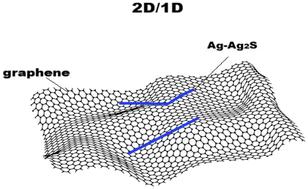Synthesis, characterization, and photocatalytic performance of 2D/1D graphene/Ag–Ag2S hybrid nanocomposites
IF 3.3
3区 化学
Q2 CHEMISTRY, INORGANIC & NUCLEAR
引用次数: 0
Abstract
The rational integration of different-dimensional nanostructures offers a powerful platform for engineering synergistic functionalities in photocatalysis. Herein, we report the controllable synthesis of novel 2D/1D graphene/silver–silver sulphide (Ag–Ag2S) hybrid nanocomposites, wherein 1D Ag–Ag2S nanowires (NWs) are uniformly anchored onto conductive graphene sheets, affording a hierarchical hybrid structure with tailored optoelectronic properties. Structural characterization via X-ray Diffraction (XRD) confirmed the coexistence of crystalline Ag, Ag2S, and Ag2O phases, evidencing both hybridization and partial oxidation during growth. Complementary Scanning Electron Microscopy (SEM) imaging revealed a homogeneous distribution of NWs across the graphene scaffold, ensuring maximized interfacial contact. Optical investigations demonstrated distinct band gap features (2.5 eV for Ag2S, 3.8 eV for Ag NWs, and 4.6 eV for Ag2O). In comparison, the composite exhibited dual transitions at 3.28 eV and 4.72 eV, attributed to interfacial charge transfer between Ag2S and graphene, alongside enhanced plasmonic carrier dynamics. FTIR analyses further corroborated the hybrid composition, highlighting O–H and C C stretching vibrations of graphene, C
C stretching vibrations of graphene, C O bands from surface PVP ligands, and Ag–S/Ag–O vibrational modes consistent with XRD assignments. Harnessing these tailored structural and electronic attributes, the graphene/Ag–Ag2S heterostructures exhibited markedly superior photocatalytic activity toward methylene blue (MB) degradation, achieving a maximum efficiency of 89.55% under acidic conditions (pH 3) after 300 min of irradiation. Kinetic analysis revealed the highest rate constant (0.386 min−1) for the graphene/Ag–Ag2S nanocatalyst in acidic medium, surpassing both pristine Ag NWs and Ag–Ag2S. This work highlights the potential of spatially engineered graphene-based heterostructures to modulate band structures, enhance charge carrier transport, and thereby improve selective photocatalytic dye removal.
O bands from surface PVP ligands, and Ag–S/Ag–O vibrational modes consistent with XRD assignments. Harnessing these tailored structural and electronic attributes, the graphene/Ag–Ag2S heterostructures exhibited markedly superior photocatalytic activity toward methylene blue (MB) degradation, achieving a maximum efficiency of 89.55% under acidic conditions (pH 3) after 300 min of irradiation. Kinetic analysis revealed the highest rate constant (0.386 min−1) for the graphene/Ag–Ag2S nanocatalyst in acidic medium, surpassing both pristine Ag NWs and Ag–Ag2S. This work highlights the potential of spatially engineered graphene-based heterostructures to modulate band structures, enhance charge carrier transport, and thereby improve selective photocatalytic dye removal.

二维/一维石墨烯/ Ag-Ag2S杂化纳米复合材料的合成、表征及其光催化性能
不同维度纳米结构的合理整合为光催化的工程协同功能提供了强大的平台。本文中,我们报道了一种新型二维/一维石墨烯/银-硫化银(Ag-Ag2S)杂化纳米复合材料的可控合成,其中一维Ag-Ag2S纳米线(NWs)均匀地固定在导电石墨烯片上,提供具有定制光电性能的分层杂化结构。通过x射线衍射(XRD)的结构表征证实了Ag、Ag2S和Ag2O相的共存,证明了在生长过程中存在杂化和部分氧化。互补扫描电子显微镜(SEM)成像显示,NWs在石墨烯支架上均匀分布,确保了最大的界面接触。光学研究显示了明显的带隙特征(Ag2S为2.5 eV, Ag NWs为3.8 eV, Ag2O为4.6 eV)。相比之下,复合材料表现出3.28 eV和4.72 eV的双跃迁,归因于Ag2S和石墨烯之间的界面电荷转移,以及增强的等离子体载流子动力学。FTIR分析进一步证实了杂化成分,突出了石墨烯的O-H和CC拉伸振动,表面PVP配体的CO带,以及与XRD分配一致的Ag-S / Ag-O振动模式。利用这些定制的结构和电子属性,石墨烯/ Ag-Ag2S异质结构对亚甲基蓝(MB)的降解表现出明显优越的光催化活性,在酸性条件下(pH 3)照射300分钟后,效率达到89.55%。动力学分析表明,石墨烯/Ag - ag2s纳米催化剂在酸性介质中的最高速率常数为0.386 min−1,超过了原始Ag NWs和Ag - ag2s。这项工作强调了空间工程石墨烯基异质结构在调节能带结构,增强载流子传输,从而提高选择性光催化染料去除方面的潜力。
本文章由计算机程序翻译,如有差异,请以英文原文为准。
求助全文
约1分钟内获得全文
求助全文
来源期刊

Dalton Transactions
化学-无机化学与核化学
CiteScore
6.60
自引率
7.50%
发文量
1832
审稿时长
1.5 months
期刊介绍:
Dalton Transactions is a journal for all areas of inorganic chemistry, which encompasses the organometallic, bioinorganic and materials chemistry of the elements, with applications including synthesis, catalysis, energy conversion/storage, electrical devices and medicine. Dalton Transactions welcomes high-quality, original submissions in all of these areas and more, where the advancement of knowledge in inorganic chemistry is significant.
 求助内容:
求助内容: 应助结果提醒方式:
应助结果提醒方式:


